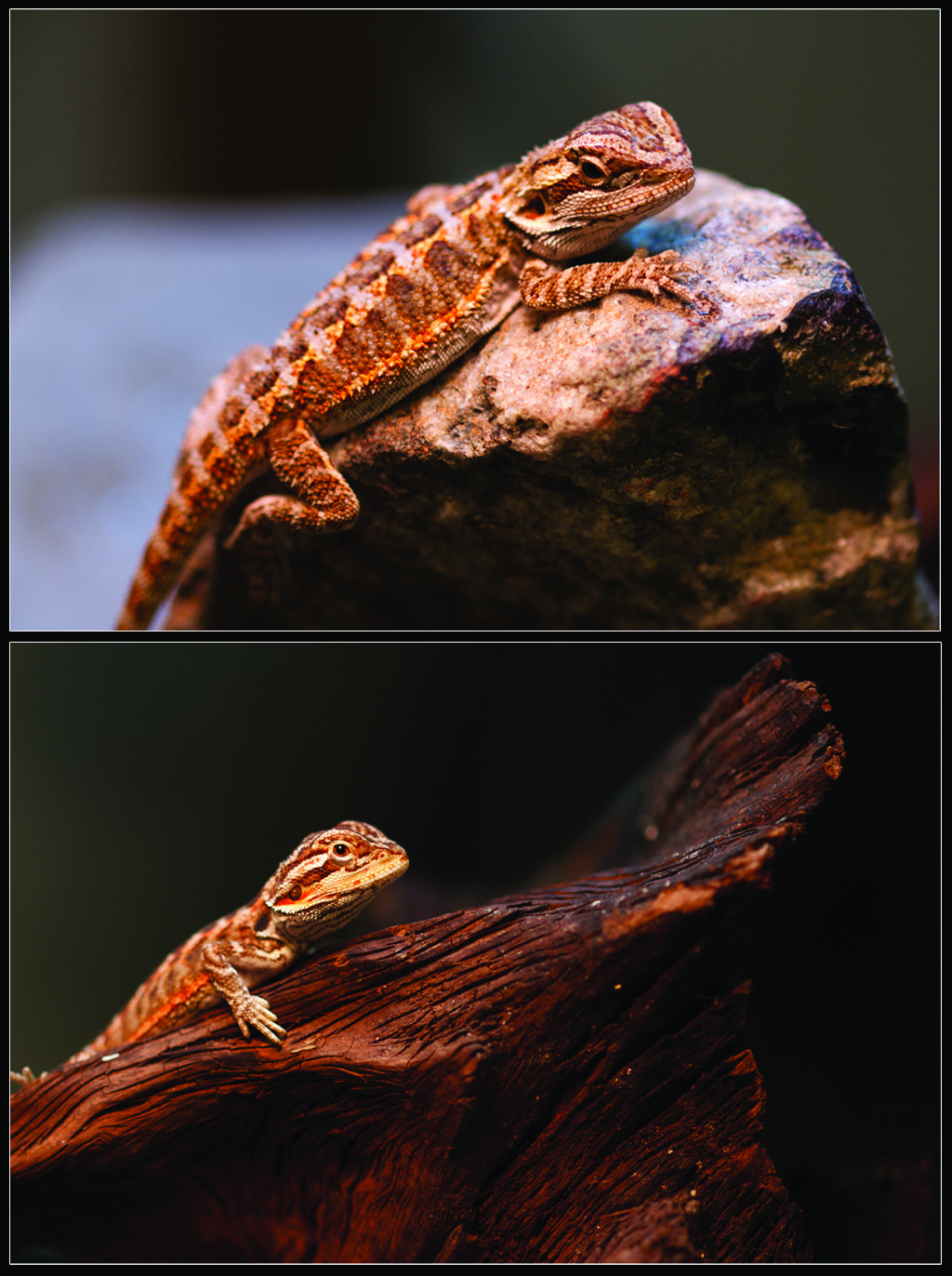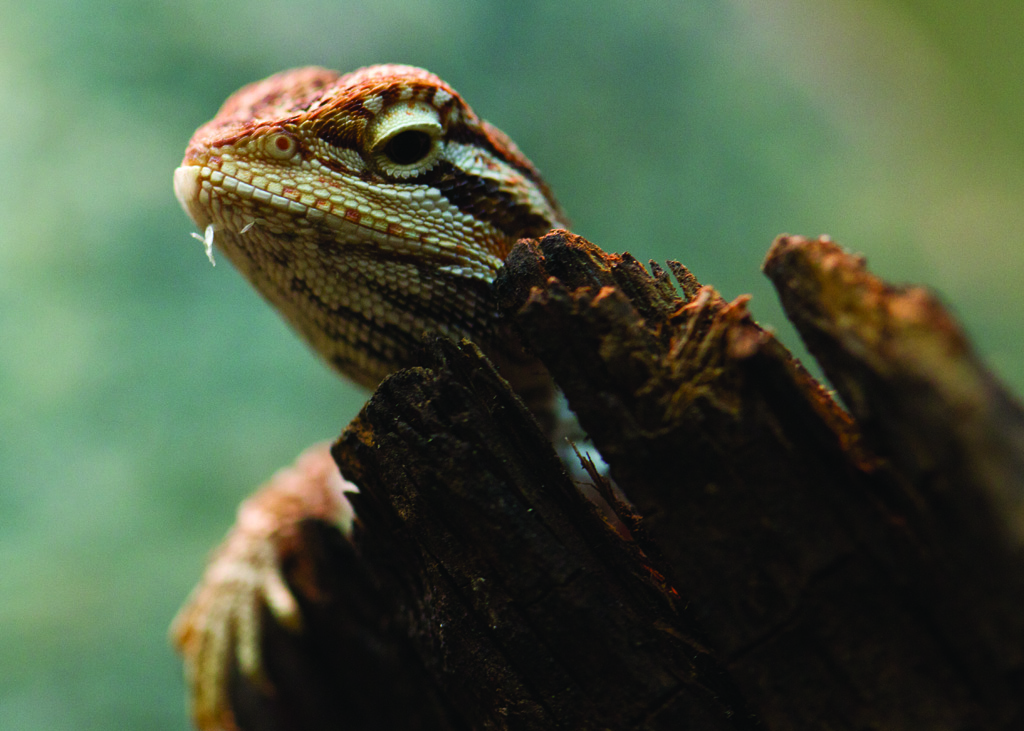Anybody that knows me, or has visited my website, can see that I spend a lot of my time experimenting and learning new techniques in the realm of photography. In addition to lugging my camera around to all ends of the earth, I also enjoy keeping up with a few hobbies. Previous to my purchase of two Bearded Dragons I had a pretty good Cichlid tank setup in my recreation room. All was great up until my 11 year old 120 gallon tank decided to leak. All of my South American Cichlids were moved to a 30 gallon tank that hosted one bad ass African Cichlid (Auratus). Needless to say, I have one fish left in the 30 gallon tank. Those South American Cichlids didn't stand a chance up against the Serial Killer (aka, African Cichlid).
So here I have this large 4 foot long by 2 feet deep by 2 feet tall aquarium that sits in my recreation room like an old WWII battleship docked in harbor collecting cobwebs. After visiting my nephew and seeing his two bearded dragons, which were medium size at the time, I quickly came up with a solution to my empty tank. Even though I made the decision to venture into the herpetology world, it took almost 6 months for me to buy my first pair of dragons.
Before I took any dragons home, I had to build a good enclosure for these little guys. The 120 gallon tank is a little excessive for dragon babies but perfect for full grown dragons. For those that wish to introduce a bearded dragon into your household, you'll need to consider the following items that happy healthy dragons will require.
- An enclosure - of course. You can use an aquarium or buy a reptile terrarium at your local pet store
- Heat lamp (depending on the size of your enclosure, between 75 and 150W - I went with the 150W bulb). This lamp puts out UVA light. Dragons, especially young ones, need areas ranging from 80 to 100 degrees to bask in. Running a heat lamp with a variable climbing structure that the little dragons and pick and choose their climate is optimal.
- Daylight florescent lamp (UVB) - mimics UVB rays that dragons naturally get from the sun - helps with digestion and overall health
- Under-the-tank heat pad (not a requirement, but I added one for good measure anyways. Dragons like to get all of their warmth from up above).
- Reptile Liner (looks like carpet/astro turf) for the bottom of the tank (substrate). Do not add sand or pebbles for baby dragons. It's really easy for these small lizards to consume sand or pebbles while eating crickets. Impaction is a real threat when using sand or pebbles as a substrate and this can KILL them.
- Food bowl (for greens and waxworms)
- Calcium and D3 supplement (sprinkled on greens and crickets)
- Gutload for crickets (feed this to your crickets a few hours before you feed them to your dragons)
- Spray bottle (water bottle). Dragons don't drink from a water bowl too well (they're not dogs). In the wild, Dragons get most of their moisture from bugs and plants but also lap up droplets from leafs or off of their head from a morning dew. Sprinkling a few droplets of water on their heads often promotes them to lap the moisture. This is the best way to assure your dragon is hydrated.
- Infrared heat sensor (used to gauge the temperature on the basking areas)
- Drift wood and slate rock (used to create a climbing structure - dragons like to climb. This is also used as a basking area for the dragons to warm up).
- Critter cage to house a few days worth of crickets (saves yourself the daily or bi-daily task of going to the pet shop).
The start-up cost for bearded dragons can vary quite a bit. I already had the enclosure and stand (120 gallon tank) but including the cost of two dragons, I still spent about $300. Baby Dragons will cost anywhere between $40 and $100 each (depending on the supply, size, and time of the year purchased). Your time must also be allocated into the cost of ownership. Dragons love live food and you'll find yourself making a few trips a week (or at least once a week if you buy in bulk) to pick up crickets. Their enclosure should be spot checked and cleaned of any waste on a daily basis. Daily sounds like a daunting task but time to feed and clean can be all completed in 20 to 30 minutes throughout your day (so I have heard - not from personal experience yet). Yes, there's maintenance, but nothing like the maintenance of owning a cat or dog.
On December 22nd 2012, I purchased two Bearded Dragons from Petsmart (Parma Branch). One, which is featured in the photo above (top lizard), I think is a male measuring at 5.5 inches in length. The other, a feisty female (I think), measures in at 5 inches. The first night in their new enclosure went well. The female had no problem warming up to me and she ate three waxworms fed to her via a feeding tong. The male on the other hand needed some more time to adjust to his new settings. He was easy to pick up but had no interest in eating the first night in the Dragon Hotel.
Over the next few months I'll be taking a daily log of these little guys. I won't be posting every day but I'll add updates along with a couple photos a few times a month. If you're into reptiles or if you are thinking about bringing one into your home sometime in the future, check back for my dragon updates. I'll try to supply as much useful information as possible.




